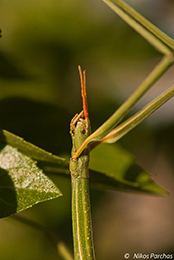Rank Species | Subspecies B. atticus atticus Order Phasmids | |
 | ||
Similar Phasmids, Bacillus rossius, Acanthoxyla prasina, Haaniella scabra, Dares ulula | ||
Bacillus atticus atticus is a species of phasmid or "walking stick" with recorded specimens in Greece, Italy, Croatia and Israel. In Cyprus, the endemic subspecies Bacillus atticus cyprius is present. Both can often be found climbing on plants and can be kept as a pet in an insectarium.
Contents
Description
Adults have a slim body about 80 mm long, with a stripe on each side. Their antennae are red and short. The forelegs are strong, around 50 mm long, painted red at their base.
Behaviour
Bacillus atticus atticus is mostly active at night, when it feeds. The usual foods of this species are plants such as ivy and lettuce. During the day, the animal stays absolutely still, camouflaged as a stick, matching the color of the plant that it's on. If disturbed, its main defense is to feign death. Like many phasmids it is parthenogenetic so it can reproduce on its own by laying eggs. The eggs are ovoid-shaped with some distinguishable glyphics around them and a sponge-like shape on the top.
Living in captivity
Right now there are no living colonies in captivity. However, they can be kept in cages around 25x25 cm with a simple paper foil at the bottom. They have to be sprayed with clean water at least twice a day and they can be fed with leaves of lettuce and other groceries.
